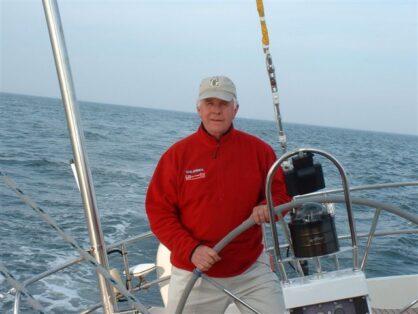Here is another chapter in our series about Bermuda Race history as we celebrate the 50th “Thrash to the Onion Patch.”
![]() Interest in ocean racing lagged until after World War I. Before the sixth Bermuda Race in 1923, race chairman Herbert L. Stone laid out a mission statement that identified ocean racing’s broad contributions to all of sailing:
Interest in ocean racing lagged until after World War I. Before the sixth Bermuda Race in 1923, race chairman Herbert L. Stone laid out a mission statement that identified ocean racing’s broad contributions to all of sailing:
“In order to encourage the designing, building, and sailing of small seaworthy yachts, to make popular cruising upon deep water, and to develop in the amateur sailor a love of true seamanship, and to give opportunity to become proficient in the art of navigation. . . .”
The sailors certainly were eager. When 22 boats crossed the starting line in 1923, Stone reported that “an instinctive cheer,releasing pent-up enthusiasm, broke from the crew of every boat, to be echoed by the spectators.”

The high spirits were contagious. Veterans of the next Bermuda Race, in 1924, went home to Michigan and England and founded the Bayview-Mackinac and Fastnet races. In 1926 the youthful Cruising Club of America teamed up with one of the oldest yacht clubs in the Western Hemisphere, the Royal Bermuda Yacht Club, to organize the race. The two clubs’ burgees (the CCA’s with a blue wave and the RBYC’s with a crown) remain on the Bermuda Race’s logo nearly 90 years later.
A Feat of Remarkable Seamanship
In 49 Bermuda Races from 1906 through 2014, a total of nearly 5,000 boats and 50,000 sailors have raced through a total of more than 3,000,000 miles of blue, green, and often white water. Occasionally there are problems. In the past two races (2012 and 2014), four boats have been awarded special Seamanship Awards in recognition of their efforts to assist competitors in trouble.

The worst accident in the race’s long history occurred in 1932. On the cold, raw first night out, as the schooner Adriana banged into a fresh sou’wester the heat from her coal cabin stove ignited some oilskins. The uncontrollable fire spread so rapidly that the decision was made to abandon ship.
Three miles ahead of Adriana was the cutter Jolie Brise and her 35-year-old owner-skipper, an adventurous English aristocrat named Henry Robert Somers Fitzroy de Vere Somerset, but known afloat as “Bobby.” Descended from dukes, he had been decorated for his service in the trenches on the Western Front (where he had lost a lung), and was described as “a man of outrageously good looks” who exuded “an element of the devil-make-care buccaneer.” His crew included Herbert L. Stone and the famous American racing helmsman Sherman Hoyt.
In an astonishing feat of seamanship, Somerset, at Jolie Brise’s long tiller, turned his engineless, heavy-displacement vessel around toward the burning Adriana, whose crew was struggling to launch a small boat and heave the spinnaker pole into the water to serve as an improvised float. As the schooner’s helmsman, Clarence Kozaly, held position, Somerset brought Jolie Brise alongside under sail. The yachts’ rails banged together, their upper rigging tangled, and Jolie Brise’s tarred deadeye lanyards were charred. Ten of Adriana’s 11 sailors jumped across to the cutter’s deck.
Only the dutiful Kozaly was left. The two yachts were several feet apart when he finally let go the wheel and made his leap, only to tumble into the gap. Sherman Hoyt desperately threw him a line, but Kozaly’s heavy clothing drew him under. After helping to save ten lives, he lost his own and is the only fatality in Bermuda Race history.
One consequence of this sad yet heroic story was its effect on the public’s opinion of sailors. Yachting, insisted the respected New York Times columnist John Kiernan, surely did not deserve its reputation as “a sissy sport for rich fellows who like to wear white pants.” Amateur yachtsmen who had “nothing to fear except broken bones and drowning” were as brave as boxers and other shoreside professional athletes. And for what?, Kiernan asked. “For money? No, for fun.”
The heroic Jolie Brise today is as a sail-training vessel, occasionally racing to Fastnet Rock and winning Tall Ships races.





























